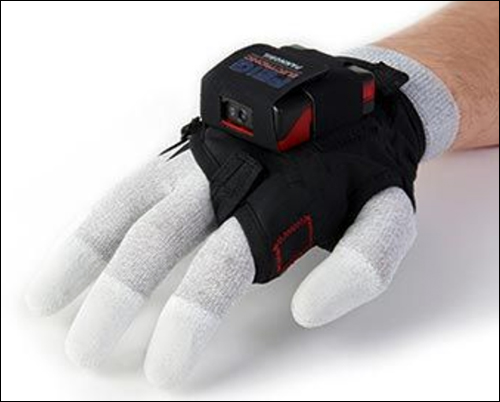RFID technology company Feig Electronics has released what it calls the first true wearable hybrid RFID reader and bar-code scanner. The device, worn as a glove, enables workers handling cargo or assets to read or scan labels on items they pick up or handle, without stopping to pick up a handheld device. The company demonstrated its HyWEAR compact fingerless glove device at last week’s RFID Journal LIVE! conference and exhibition. The device was launched at LogiMat in February 2019.
The reading and scanning system is designed for companies that have a manual material-handing process, according to Mike Hrabina, Feig’s global product manager. The device comes with a built-in 1D and 2D bar-code imager, as well as a UHF RFID reader, and fits into a glove that fits over a person’s hand—even if the user is wearing his or her own glove. It is currently being tested by airlines, as well as by delivery service providers.
Companies already make handheld devices that can scan bar codes or read tags, including one that fits over a user’s fingers, provided by Technology Solutions (UK) Ltd. (see RFID Readers Fit Like a Glove with New Atlas RFID Release). But the HyWEAR unit is the first to come in the form of a wearable item of clothing, Hrabina says.
“This device is intended for manual material-handling processes,” Hrabina explains, “in which they are manipulating items and also include a data-collection task.” It is designed to have a longer-range optical function to scan bar codes from a distance of 3 feet, while the UHF RFID reader is designed for short-distance reading of 12 inches or less. In that way, users can be sure they don’t pick up stray RFID reads from items in the area that they are not moving or manipulating.
The device is intended to meet the needs of users who may be transitioning into RFID tag tracking, as well as those scanning bar codes. Companies are increasingly introducing RFID tag reading into their processes, Hrabina says, in order to gain information about goods, such as on airline passenger baggage, parcels being delivered to consumers and products being moved through a supply chain. However, bar codes are still prevalent, meaning users often need to be able to capture the ID numbers of items via both technologies. That can mean picking up and putting down handheld devices, which slows processing time.
For instance, airlines are using bar codes on baggage to comply with IATA Resolution 753, which requires that they monitor the movements of bags during aircraft loading, arrival and transfer. Bar codes require workers to orient and then scan the label on each bag. With the advent of RFID in this environment, Feig reports, the process time can be reduced by about six seconds per bag. That can mean shortening loading and unloading processes, potentially creating the opportunity to schedule an additional flight at an airport every day, thanks to the added efficiency.
But while some airlines transition to RFID technology, bar-code scanning is still taking place at most airports, so a hybrid solution is necessary. “IATA doesn’t demand specific technology,” Hrabina notes, so both technologies are likely to be used for the foreseeable future. Similarly, bar codes on parcels being delivered to consumers are commonplace, but there is an evolution of implementing RFID as well. “No matter what industry segment, you may see both RFID and bar codes in use. This is a great migration tool as RFID becomes more prevalent.”
The HyWEAR comes in three versions: the hybrid RFID and bar-code scanning device, as well as separate bar-code scanner and UHF RFID reader models. It includes Wi-Fi roaming functionality to make it easier to share read and scan data with a server. Traditional devices must be networked to a nearby router, but the HyWEAR device can roam from one wireless cell to another as a user moves around a facility, such as an airport or large warehouse, without having to log in to a new router. The HyWEAR also comes with LED lights and an audible tone to signal that a tag has been read or scanned—but it also includes a vibration buzzer, providing feedback for users, especially in noisy environments.
A switch next to the glove’s index finger can be used to trigger the device, in order to conserve battery life when not in use. Typically, the device’s battery can accommodate a 10-hour working shift, using an exchangeable or rechargeable battery. Users can also switch the HyWEAR’s operation function between RFID and bar-code scanning. Its UHF frequencies range from 865 to 868 MHz (for use in Europe) to 902 to 928 MHz (for North America).
The HyWEAR also has Bluetooth functionality so that it can share data with a smartphone or another Bluetooth-enabled device. As such, when an individual carries a phone or tablet, either in a pocket or simply in a vehicle, that device can capture the HyWEAR read data and forward the collected information to a server via a cellular connection when a user is on the road.
The HyWEAR can receive and transmit BLE beacon data as well. When it captures transmissions from a beacon, software users can view the location of that HyWEAR device, indicating that a worker wearing the glove has entered or left a specific area. They could also view what items that individual is carrying. “It’s all part of this connected world,” Hrabina states.
The HyWEAR glove is built to be low-cost (the suggested retail price is $1,800 with a cuff glove and a rechargeable battery), without requiring extra hardware, such as a display or keyboard, that tends to raise the price in other handheld devices. Samples are now in use by airlines and partial distribution (package delivery) companies.



